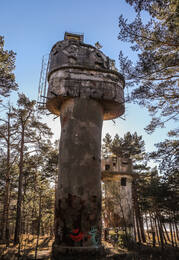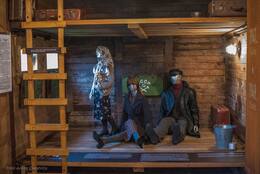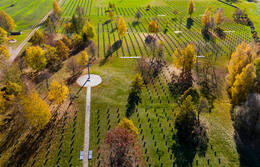Antrasis pasaulinis karas ir jo padariniai – sovietinė okupacija Pietų Latvijoje ir Latgaloje
Diena 1.
95 km
Liepoja - Skrunda - Saldus
Praktinė informacija
- Maršrutas skirtas kaip vadovas – kaip optimaliai keliauti po regioną ar šalį, arba dvi šalis, siekiant pažinti jų karinį paveldą;
- Vairuotojas turi pats suplanuoti – kiek iš rekomenduojamų objektų ir vietų jis gali apžiūrėti per vieną dieną;
- Prieš kelionę reikėtų pasitikrinti lankytinų vietų (muziejų, kolekcijų, įtvirtinimų ir kt.) darbo laiką;
- Vietose, kur reikalinga išankstinė registracija (vietiniai gidai, privačios kolekcijos, kitos), apsilankymą būtina užsisakyti, nurodant datą ir laiką. Jei kelionė atšaukiama, apie tai reikia informuoti užregistruotas vietas;
- Apgyvendinimą būtina užsisakyti iš anksto. Vasaros sezonu apgyvendinimo paslaugos gali būti neprieinamos, ypač pajūryje. Kai kurios maitinimo įstaigos žiemos sezonu gali nedirbti;
- Kelionei rinkitės ne tik vasarą, bet ir kitus metų laikus;
- Latvijos, Lietuvos ir Estijos sienas keliais galima laisvai kirsti be apribojimų ir bet kuriuo paros metu. Vykstant iš vienos šalies į kitą, būtina su savimi turėti asmens tapatybės kortelę arba pasą;
- Apsilankykite turizmo informacijos centruose, kur galite gauti papildomos informacijos, brošiūrų ir žemėlapių.
Lankytinos vietos
Karosta, Liepojos karinis uostas (ekskursija)
Karosta yra didžiausia istorinė karinė teritorija Baltijos šalyse ir užima beveik trečdalį visos Liepojos teritorijos. Karosta – unikalus karinių ir įtvirtinimų pastatų kompleksas Baltijos jūros pakrantėje, turintis ypatingą reikšmę Latvijos ir pasaulio istorijoje bei architektūroje. Karostoje yra tokie karinio paveldo objektai kaip Šiaurinis molas ir fortai, Redanas, Karostos kalėjimas, Karostos vandens bokštas, Šv. Nikolajaus stačiatikių Jūros katedra, Oskaro Kalpako tiltas ir kiti.
Trėmimams naudotas galvijinis vagonas – muziejus Skrundos geležinkelio stotyje
1941 m. birželio ir 1949 m. kovo mėn. trėmimams atminti Skrundos geležinkelio stotyje pastatytas atminimo akmuo ir keturašis vagonas, kuris taip pat tarnauja kaip trėmimams skirtas muziejus. Tai pirmasis vagono tipo muziejus Latvijoje, kuriame nuolat eksponuojamos iš Skrundos stoties ištremtų žmonių nuotraukos, laiškai, atsiminimai, dokumentai ir įvairūs daiktai. Skrundos stotis buvo tremtinių surinkimo vieta ir viena iš trijų regiono stočių, į kurią buvo atvežti žmonės iš Skrundos ir Kuldygos apylinkių. 1941 m. iš čia į Krasnojarsko kraštą Sibire buvo ištremta pirmojo atkurtos Latvijos Respublikos prezidento Gunčio Ulmanio šeima.
Deportacijų pagalba sovietai susidorojo su nacionalinių partizanų šalininkais ir tuo pačiu metu baugino likusius kaimo gyventojus, versdami juos stoti į kolūkius.
Saldaus vokiečių kareivių kapinės
Saldaus vokiečių kareivių kapinės yra prie Saldaus–Ežerės plento. Kapinėse, užimančiose 8 hektarų plotą, yra apie 25 000 vokiečių kareivių, taip pat kai kurių Latvijos legionierių palaikai. Perlaidojimai vyksta nuo 1997 m.
Nuo gegužės 1 d. iki spalio 1 d. memorialiniame kambaryje galima apžiūrėti parodą apie Kuršo mūšius. Šiuo laikotarpiu memorialinis kambarys dirba darbo dienomis nuo 9:00 iki 17:00 val., o šeštadieniais ir sekmadieniais kapinėse dirba ir gidas. Taip pat galima susipažinti su Saldaus vokiečių kareivių kapinėse palaidotų ir visoje Latvijoje žuvusių kareivių sąrašais.
Vietos pavalgyti
- Liepojoje žiūrėkite liepaja.travel
- Taverna "Mežavējš", Ryga - Liepojos plentas, www.celotajs.lv/lv/e/mezavejs
- Salduje žr. turisms.saldus.lv
Vietos apsistoti
- Liepojoje žiūrėkite liepaja.travel
- Skrundoje žiūrėkite skrundasmuiza.lv
- Salduje žr. turisms.saldus.lv






